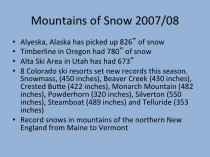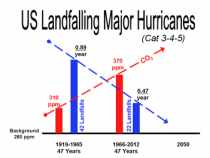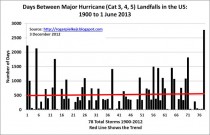Dr. William Gray

The main misconception among those who believe in human-induced global warming is to assume that all the many large and varying energy terms of the natural climate system remain constant over long periods and that the only changes that matter for climate are the very miniscule variations of human affects. As extensive and tragic as Sandy’s destruction has been, it is not at all beyond the range of what is known about the natural variability of the different meteorological elements which came together to produce it. What is more amazing, at least from an intellectual point-of-view, is the number of prominent government officials, the media, and private citizens who have concluded that Sandy’s destruction was the result (or partly the result) of human influences.
There is no rational basis for such a conclusion other than the prevalent psychological need of so many people to assign a simple explanation for any unusually rare and destructive weather event. Associated with this need for a simple explanation is the parallel psychological need of so many to find a scapegoat for our misfortunes? And this need for a scapegoat can often take the form of blaming ourselves (original sin) or the society in which we live.
History tells us of the strong link between the deteriorating weather which occurred in Europe between the Medieval Warm Period (MWP) and the Little Ice Age (LIA), and the burning of women believed to be witches. Estimates are that fifty thousand or more witches were burned to death during the 15th through 17th centuries in Europe. These women were imagined to have a pack with the Devil that enabled them to bring forth damaging weather events or deterioration of climate. And if the weather improved after such burnings it was taken as a sign that these women did indeed have a direct link to the Devil.
Despite the world’s enlightenment that has occurred since those times… there appears to still be a residue desire within our human nature, even today, for an easy explanation for unusual damaging events, a need to find a scapegoat and a need to look to ourselves for part of the explanation of destructive weather events like hurricanes, tornadoes, droughts, heat waves, floods, etc. Blaming last summer’s US droughts, wild fires, and hot weather on human-induced climate change is a recent example. As if we humans would ever be able to influence such large and unique nature events!
Why must we, as in previous ages, continue to try to suggest that humans may have been a contributing element in major destructive weather events? If it were really possible for humans to be a contributor to severe weather or worsening climate, would it not also be logical to believe that humans might also be a contributing element to spells of good weather or favorable climate change?
The longest recorded period of no major (Cat 3, 4, 5) hurricane landfalls in the US has occurred during the last seven years (2006 to 2012). We have also had 20 fewer major US hurricane landfall events in the last 47 year period (1966 to 2012) than we had during the earlier 47 year (1919 to 1965) period. And this decrease in landfalling major hurricanes occurred during the time of rising CO2 levels. If humans could really influence destructive climate-weather events like Sandy, should they not also be able to take some credit for influencing the recent decades of reduced number of US landfalling major hurricanes? Landfalling US major hurricanes are known to cause about 80-85 percent of all normalized US landfalling tropical cyclone destruction.
It appears that we humans have, unknowingly, made an enormous contribution in recent decades to the reduction of US hurricane destruction (see Figure). Should we not pat ourselves on the back and continue to increase our fossil-fuel utilization?
Illustration of how US landfalling major hurricane numbers have been trending downward while atmospheric CO2 amounts have been increasing.
Roger Pielke Jr.
Record US Intense Hurricane Drought Continues
The graph above provides an update to data on the remarkable ongoing US “intense hurricane drought.” When the Atlantic hurricane season starts next June 1, it will have been 2,777 days since the last time an intense (that is a Category 3, 4 or 5) hurricane made landfall along the US coast (Wilma in 2005). Such a prolonged period without an intense hurricane landfall has not been observed since 1900.
Some thoughts:
Even with hurricane Sandy and its wide impacts, things will indeed get worse. The US coastlines as a whole have actually been very lucky with respect to hurricanes since 2005, with aggregate damage (even including aggressive estimates for Sandy) 2006-2012 falling at or below the historical average. Sandy made landfall as a post-tropical cyclone of hurricane strength—a phenomena that has only been documented 3 times since 1900 (1904, 1924, 1925—later this week I’ll have a post on Sandy damage estimates).
The long-term intense hurricane drought means that a mere “regression to the mean” will see more hurricane landfalls and considerably higher damage in the years to come. The fashionable talk these days of a “new normal” is of course utter bullsh*t. Just wait until we return to the “old normal”—I know that it may be hard to believe, but both hurricane damage and climate hype are set to increase dramatically in the years to come.
----------------
Guest comment BK
“The long-term intense hurricane drought means that a mere “regression to the mean” will see more hurricane landfalls and considerably higher damage in the years to come. The fashionable talk these days of a “new normal” is of course utter ( ) . Just wait until we return to the “old normal”—I know that it may be hard to believe, but both hurricane damage and climate hype are set to increase dramatically in the years to come.”
Want to talk about “normal”? The period from 1970 to present has been remarkably quiet meteorologically for hurricane impacts to the U.S. Yes, 2004 and 2005 were very bad, but it is isolated to those two years in a 42 year period taking the seasons as a whole (not talking about number of named storms per season here either, but that has it’s own share of problems over the climatic record).
Now, if you look at the period 1925-1969, it was way worse, again, strictly from a meteorological standpoint. If you look at the number of major hurricane landfalls in the U.S from that period and where they hit, it is no contest to the current period. There were not just a few bad seasons for landfalls either, they were spread out over multiple years, esp. if you look at Florida, which in itself much worse b/c we had time rebuilt after one, and a few years later, it all get damaged/destroyed again. And there is New England...1938, 1944, 1954 (2), and 1960? That averages one hurricane every 4-5 years over that 22 year period. How many hurricanes have made landfall over Long Island or the New England coast since 1960?, three...Belle (1976), Gloria (1985), and Bob (1991).
So when talking about “normals” you have to be very careful. I will state the disclaimer than I realize hurricanes are only one part of equation in global climate, but 1) they are an important factor in the grand scheme of things I believe b/c of their enormous heat extraction and dissipation both from the air and sea and heat distribution between the tropics and polar regions, and 2) individual hurricane strikes are often used as poster childs to say the wx is getting worse. They are getting worse, but only from a sociological and economical point of view, not meteorological. We need to stick to the science of meteorology itself here if we are to properly view things in the correct perspective. The shock and awe factor is not part of practicing good objective science.
I discussed Sandy in this WUWT TV segment. I was not aware I was on camera at the end when I did my Andrea Bocelli imitation. I usually do radio with my eyes closed so I am not distracted.




